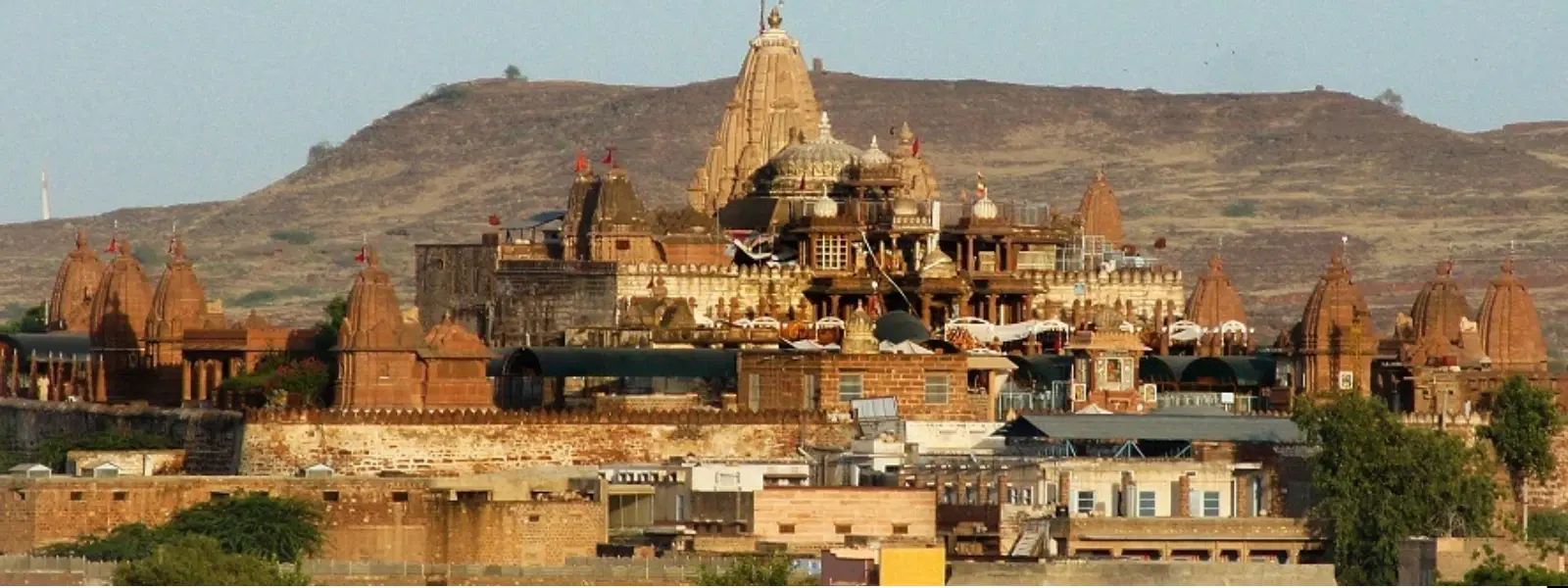
Hotels
•04 min read

Osian, often known as the "Khajuraho of Rajasthan," captivates with its rich cultural tapestry and mesmerizing architectural heritage. Nestled in the heart of the Thar Desert near Jodhpur, this historic town is renowned for its ancient Hindu and Jain temples. These sacred sites, celebrated for their intricate carvings and spiritual ambiance, have long drawn devotees, history buffs, and cultural explorers alike. In this blog, we will guide you through seven must-visit temples in Osian, unveiling the historical significance, architectural marvels, and deep spirituality embedded within each structure.
Once a prominent center during the Gurjara-Pratihara dynasty, Osian played a pivotal role in the religious landscape of Rajasthan. The town's temples have long been revered as pilgrimage sites by both the Jain and Hindu communities. Devotees from all corners of India journey to these ancient shrines, eager to witness their timeless beauty and connect with centuries-old traditions.
The temples in Osian are a testament to the harmonious fusion of Jain and Hindu artistry. Their intricate carvings, detailed sculptures, and unique architectural styles reflect the creative genius of a bygone era. Visitors will be enthralled by the delicate floral motifs and mythological depictions, which have withstood the test of time.
The Sachiya Mata Temple is an iconic Hindu shrine, dedicated to the revered Goddess Sachiya Mata. Its historic origins and distinct architectural highlights make it a beacon for both devotees and history enthusiasts. The temple’s spiritual significance and vibrant murals are a visual treat, drawing countless visitors year after year.
Dedicated to Lord Mahavira, this Jain pilgrimage site is celebrated for its tranquil ambiance and intricate carvings. The temple stands as a profound symbol of Jain traditions and ancient architectural brilliance. Its peaceful aura invites introspection and reverence, making it a must-see for seekers of spiritual solace.
The Surya Temple, devoted to the Sun God, is a striking example of bold architectural ingenuity. Its design, which channels light and shadow in dramatic ways, exemplifies the deep connection between celestial forces and earthly artistry. This temple enriches the spiritual landscape of Osian with its distinctive charm.

Unique in its dual dedication, the Harihara Temple honors both Lord Vishnu and Lord Shiva. This melding of two significant deities is reflected in the temple’s grand artistry and diverse sculptures. The dual religious significance underscores the town’s inclusive cultural and spiritual heritage.
The Pippala Devi Temple is steeped in history, with roots that mirror the fertile cultural landscape of Osian. Its robust architecture and historical relevance make it a cornerstone of the town’s temple complex, resonating with both devotees and tourists.
The Vishnu Temple is closely connected to the Vaishnava tradition, showcasing elegant stonework and time-honored craftsmanship. Its serene setting complements its spiritual role, inviting visitors to pause and reflect on the deeper narratives of faith and devotion.
Beyond these standout sites, Osian is home to several other shrines that contribute to its rich fabric of religious and architectural heritage. Each temple, from the lesser-known Jain Mahavira Temple to additional communal shrines, offers a unique perspective on Rajasthan temple tourism and the diverse legacy of ancient India.
Walk through the stone corridors of Osian temples and you will find walls adorned with detailed carvings that tell stories of deities, legends, and nature. The sculptures, full of life and fluidity, capture priceless moments from mythology and history. These artistic embellishments are not just decorative—they serve as a visual narrative of the ancient cultures that once thrived here.
The layout of these temples, influenced by architectural insights from the Gupta and Gurjara-Pratihara periods, demonstrates both precision and creativity. Their robust construction techniques have allowed these monuments to endure for centuries. Visitors can admire the symmetry and thoughtful planning evident in each structure, which continues to inspire architects and historians alike.

For centuries, Osian temples have served as key destinations for pilgrims from both the Jain and Hindu faiths. These sacred sites nurture a sense of community and spiritual growth, providing a serene backdrop where age-old rituals and festivals bring people together. The confluence of religious practices here is a unique feature of Rajasthan's cultural mosaic.
These temples are not just relics of a storied past; they are vibrant cultural landmarks that continue to influence Rajasthan’s identity today. Their preserved beauty and historical narratives attract travelers eager to explore a world where art, faith, and heritage intertwine. Osian temples near Jodhpur encapsulate the spirit of ancient India, inviting you on a journey through time and tradition.
Osian is home to one of the oldest Jain temples in Rajasthan, dedicated to Lord Mahavira. This temple is a testament to the Jain community’s deep-rooted presence in the region and their contributions to its architectural heritage.
There are several Hindu and Jain temples in Osian, with seven prominent ones being key attractions for visitors.
The Mahavira Jain Temple in Osian is one of the oldest Jain temples in Rajasthan, showcasing ancient architectural brilliance.
Yes, Osian is a must-visit destination for its rich history, stunning temple architecture, and spiritual significance.
The Mahavira Jain Temple in Osian is one of the most famous Jain temples in Rajasthan, attracting pilgrims and tourists alike.
Osian stands as a vibrant testament to the ancient legacy of Jain and Hindu traditions near Jodhpur. Its temples, with their breathtaking blend of spirituality, history, and architecture, offer a window into the soul of Rajasthan. Whether you are a pilgrim or a cultural enthusiast, exploring these monumental shrines is an experience that promises both inspiration and insight into the rich tapestry of ancient India.